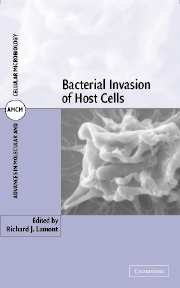Book contents
- Frontmatter
- Contents
- Contributors
- Preface
- Bacterial Invasion of Host Cells
- 1 Invasion mechanisms of Salmonella
- 2 Shigella invasion
- 3 How Yersinia escapes the host: To Yop or not to Yop
- 4 Stealth warfare: The interactions of EPEC and EHEC with host cells
- 5 Molecular ecology and cell biology of Legionella pneumophila
- 6 Listeria monocytogenes invasion and intracellular growth
- 7 N. gonorrhoeae: The varying mechanism of pathogenesis in males and females
- 8 Group A streptococcal invasion of host cells
- 9 Invasion of oral epithelial cells by Actinobacillus actinomycetemcomitans
- 10 Invasion by Porphyromonas gingivalis
- Index
- Plate section
- References
10 - Invasion by Porphyromonas gingivalis
Published online by Cambridge University Press: 21 August 2009
- Frontmatter
- Contents
- Contributors
- Preface
- Bacterial Invasion of Host Cells
- 1 Invasion mechanisms of Salmonella
- 2 Shigella invasion
- 3 How Yersinia escapes the host: To Yop or not to Yop
- 4 Stealth warfare: The interactions of EPEC and EHEC with host cells
- 5 Molecular ecology and cell biology of Legionella pneumophila
- 6 Listeria monocytogenes invasion and intracellular growth
- 7 N. gonorrhoeae: The varying mechanism of pathogenesis in males and females
- 8 Group A streptococcal invasion of host cells
- 9 Invasion of oral epithelial cells by Actinobacillus actinomycetemcomitans
- 10 Invasion by Porphyromonas gingivalis
- Index
- Plate section
- References
Summary
Porphyromonas gingivalis cells are Gram-negative, anaerobic, nonmotile short rods that produce black pigmented colonies on blood agar. The taxonomy of the species dates back to 1921 when Oliver and Wherry isolated an organism from a variety of oral and nonoral sites that they were to designate Bacterium melaninogenicum. This heterogeneous grouping was later subdivided into nonfermenters, weak fermenters, and strong fermenters. After a number of status changes within the genus Bacteroides, asaccharolytic oral isolates were assigned to the taxon P. gingivalis. The primary ecological niche of P. gingivalis is in the subgingival crevice, the gap between the surfaces of the tooth and the gingiva (gum); however, the organism can be found elsewhere in the mouth, including supragingival (above the gum) tooth surfaces, the tongue, tonsils, and buccal (cheek) mucosa. Although the species has been associated with odontogenic abscesses and nonoral infections (discussed later), the primary pathogenic potential of P. gingivalis is in periodontal disease. The periodontal tissues include the gingiva, periodontal ligament, and alveolar bone, and they constitute the supporting tissues of the teeth. Chronic destruction of the periodontium, such as occurs in periodontal diseases, can eventually lead to exfoliation of teeth and is the most common cause of tooth loss in adults. Periodontal diseases vary in severity and age of onset, and P. gingivalis is associated, either alone or in combination with other bacteria, with the most severe manifestations.
- Type
- Chapter
- Information
- Bacterial Invasion of Host Cells , pp. 295 - 314Publisher: Cambridge University PressPrint publication year: 2004
References
- 1
- Cited by

